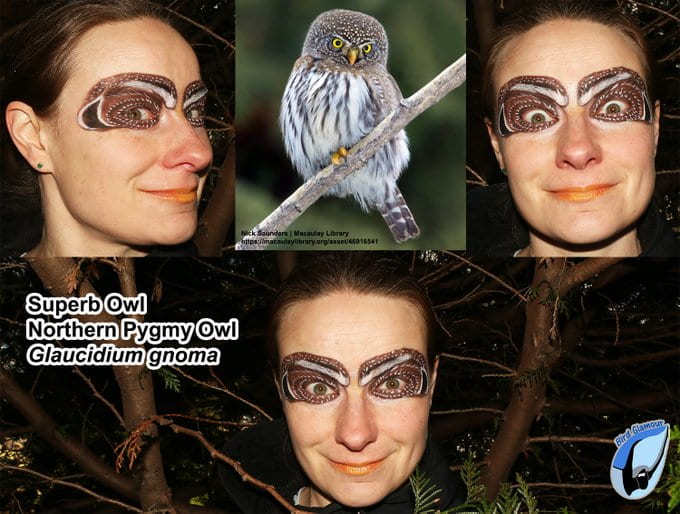
Feature Friday: Bird Glamour
This week’s Feature Friday is about a ichnologist with an itch for bird watching. Through her observations of birds, she was inspired to start portraying the amazing and distinctive marks of birds in the form of awesome eye-makeup looks.
“Bird Glamour was one of those “light bulb” moments in May 2017. A friend was having this sick run of owl sightings and posted a picture of a Short-eared Owl he saw. He asked if it was a Snowy Owl because it was so pale. I told him that it’s a Short-eared Owl because of its dark smoky eye look. I was a complete makeup newbie at that point (I still think that I am!) but I knew “smoky eye” was a makeup term. It kept rattling around in my head for a few days. Then I thought “Hey: what if I actually used cosmetics to showcase the colors and patterns we see on birds, and use that as a conversation starter for bird science communication?” I posted my first image on June 9, 2017 just to see what people would think.”

And thus Bird Glamour was born! Here Lisa replicates intricate and distinctive markings seen on birds with elaborate and detailed makeup looks. It’s not only an awesome way to highlight the differences in bird species, but also to raise awareness of the variety of species people see in the world around them.
“My main goal is to get people interested and excited about the birds that they see everyday. When you are excited about something you want to know more about it. When you know more about an animal and its ecosystem, you start to care about what happens to it and we want to treat it well. I want people to care about the habitats and environments that we share with birds everyday.
With that goal in mind Bird Glamour is spreading its wings and expanding into other wildlife with Glamorous By Nature! My 5-year goal is to explore the complex and exciting ecosystems of the Pacific Coast and draw attention to issues impacting these habitats by showcasing different animals (birds, fish, reptiles, amphibians, and a whole bunch of invertebrates!) that live there. I’ll be posting videos of visits to these areas so that people can digitally visit these habitats with me.”

Lisa’s scientific area of expertise is fossilised footprints from the time of dinosaurs. The study of footprints and traces left behind by organisms is called Ichnology. She specialises in the fossilised footprints of birds from the Cretaceous-age (about 145 – 66 million years ago) that lived alongside the much larger dinosaurs. Bird skeletons are so fragile: they have a poor chance of fossilising (with great exceptions of the fossil Cretaceous bird skeletons from China). One bird, however, can leave countless footprints in its lifetime. Sometimes all we know about the Cretaceous-age birds from an area is from the fossilised bird footprints. Lisa also uses footprints of present day birds to better understand Cretaceous-age bird footprints, so it’s not uncommon to find her crouched in a marsh or next to a muddy pond watching birds!

I’ll leave you with Lisa’s awesome response when I asked I asked Lisa her she thinks science communication is important:
“Science communication is an essential part of science. Science discovers how the world works. Science communication tells the story of these discoveries so that we can connect with our world. Science communication shows us where we fit into this great big fascinating picture. Science communication shows us that we are a part of this world, not a separate, disconnected observer.”

Keep up with Lisa on her Website, Twitter or through Instagram.
Categories